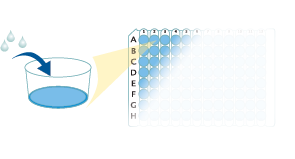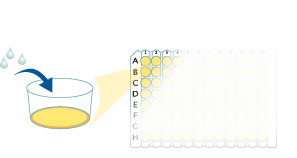Human EGFR Quantikine ELISA Kit Summary
Product Summary
Precision
Cell Culture Supernates, Human Milk
| Intra-Assay Precision | Inter-Assay Precision | |||||
|---|---|---|---|---|---|---|
| Sample | 1 | 2 | 3 | 1 | 2 | 3 |
| n | 20 | 20 | 20 | 40 | 40 | 40 |
| Mean (pg/mL) | 1.65 | 5.08 | 10.6 | 1.63 | 5 | 10 |
| Standard Deviation | 0.094 | 0.17 | 0.507 | 0.144 | 0.416 | 0.816 |
| CV% | 5.7 | 3.3 | 4.8 | 8.8 | 8.3 | 8.2 |
Serum, EDTA Plasma, Heparin Plasma
| Intra-Assay Precision | Inter-Assay Precision | |||||
|---|---|---|---|---|---|---|
| Sample | 1 | 2 | 3 | 1 | 2 | 3 |
| n | 20 | 20 | 20 | 40 | 40 | 40 |
| Mean (pg/mL) | 1.69 | 5.33 | 11.2 | 1.7 | 5.21 | 10.4 |
| Standard Deviation | 0.072 | 0.199 | 0.616 | 0.161 | 0.522 | 1.03 |
| CV% | 4.3 | 3.7 | 5.5 | 9.4 | 10 | 10 |
Recovery
The recovery of EGF R spiked to levels throughout the range of the assay in various matrices was evaluated.
| Sample Type | Average % Recovery | Range % |
|---|---|---|
| Cell Culture Media (n=4) | 98 | 86-106 |
| EDTA Plasma (n=4) | 99 | 91-108 |
| Heparin Plasma (n=4) | 101 | 92-111 |
| Serum (n=4) | 101 | 89-117 |
Linearity
Scientific Data
Product Datasheets
Preparation and Storage
Background: EGFR
The EGF R subfamily of receptor tyrosine kinases comprises four members: EGF R (also known as HER-1, ErbB1, or ErbB), ErbB2 (Neu, HER-2), ErbB3 (HER-3), and ErbB4 (HER-4). All family members are type I transmembrane glycoproteins with an extracellular ligand binding domain containing two cysteine-rich domains separated by a spacer region and a cytoplasmic domain containing a membrane-proximal tyrosine kinase domain followed by multiple tyrosine autophosphorylation sites. The human EGF R cDNA encodes a 1210 amino acid (aa) precursor with a 24 aa signal peptide, a 621 aa extracellular domain (ECD), a 23 aa transmembrane segment, and a 542 aa cytoplasmic domain. Soluble receptors consisting of the extracellular ligand binding domain are generated by alternate splicing in human and mouse. Within the ECD, human EGF R shares 88% aa sequence identity with mouse and rat EGF R. It shares 43% - 44% aa sequence identity with the ECD of human ErbB2, ErbB3, and ErbB4. EGF R binds a subset of the EGF family ligands, including EGF, amphiregulin, TGF-alpha, betacellulin, epiregulin, HB-EGF, and epigen. Ligand binding induces EGF R homodimerization as well as heterodimerization with ErbB2, resulting in kinase activation, heterodimerization tyrosine phosphorylation and cell signaling. EGF R can also be recruited to form heterodimers with the ligand-activated ErbB3 or ErbB4. EGF R signaling regulates multiple biological functions including cell proliferation, differentiation, motility, and apoptosis. EGF R is overexpressed in a wide variety of tumors and is the target of several anti-cancer drugs.
Assay Procedure
Refer to the product- Prepare all reagents, standard dilutions, and samples as directed in the product insert.
- Remove excess microplate strips from the plate frame, return them to the foil pouch containing the desiccant pack, and reseal.
- Add 100 µL of Assay Diluent to each well.
- Add 50 µL of Standard, control, or sample to each well. Cover with a plate sealer, and incubate at room temperature for 2 hours.
- Aspirate each well and wash, repeating the process 3 times for a total of 4 washes.
- Add 200 µL of Conjugate to each well. Cover with a new plate sealer, and incubate at room temperature for 2 hours.
- Aspirate and wash 4 times.
- Add 200 µL Substrate Solution to each well. Incubate at room temperature for 30 minutes. PROTECT FROM LIGHT.
- Add 50 µL of Stop Solution to each well. Read at 450 nm within 30 minutes. Set wavelength correction to 540 nm or 570 nm.





Citations for Human EGFR Quantikine ELISA Kit
R&D Systems personnel manually curate a database that contains references using R&D Systems products. The data collected includes not only links to publications in PubMed, but also provides information about sample types, species, and experimental conditions.
4
Citations: Showing 1 - 4
Filter your results:
Filter by:
-
Soluble EGFR, a hepatokine, and adipsin, an adipokine, are biomarkers correlated with distinct aspects of insulin resistance in type 2 diabetes subjects
Authors: M Kyohara, J Shirakawa, T Okuyama, Y Togashi, R Inoue, J Li, D Miyashita, Y Terauchi
Diabetol Metab Syndr, 2020-09-29;12(0):83.
Species: Human
Sample Types: Plasma
-
Interleukin 4, interleukin 6 and osteopontin-serological markers of head and neck malignancy in primary diagnostics: A pilot study.
Authors: Aderhold C, Grobschmidt G, Sauter A, Faber A, Hormann K, Schultz J
Oncol Lett, 2014-07-04;8(3):1112-1118.
Species: Human
Sample Types: Serum
-
Cancer cells induced to express mesenchymal phenotype release exosome-like extracellular vesicles carrying tissue factor.
Authors: Garnier, Delphine, Magnus, Nathalie, Lee, Tae Hoon, Bentley, Victoria, Meehan, Brian, Milsom, Chloe, Montermini, Laura, Kislinger, Thomas, Rak, Janusz
J Biol Chem, 2012-11-01;287(52):43565-72.
Species: Human
Sample Types: Cell Culture Supernates
-
Morphological and biochemical features of obesity are associated with mineralization genes' polymorphisms.
Authors: Korostishevsky M, Cohen Z, Malkin I
Int J Obes (Lond), 2010-03-16;34(8):1308-18.
Species: Human
Sample Types: Plasma
FAQs
No product specific FAQs exist for this product, however you may
View all ELISA FAQsReviews for Human EGFR Quantikine ELISA Kit
There are currently no reviews for this product. Be the first to review Human EGFR Quantikine ELISA Kit and earn rewards!
Have you used Human EGFR Quantikine ELISA Kit?
Submit a review and receive an Amazon gift card.
$25/€18/£15/$25CAN/¥75 Yuan/¥2500 Yen for a review with an image
$10/€7/£6/$10 CAD/¥70 Yuan/¥1110 Yen for a review without an image









